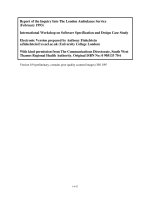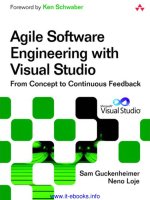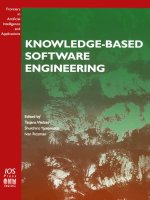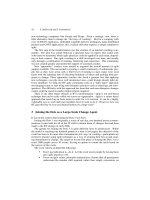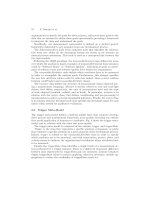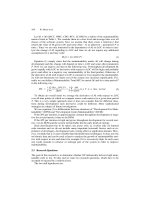Workshop Identifying Gaps between HCI, Software Engineering, and Design, and Boundary Objects to Bridge Them
Bạn đang xem bản rút gọn của tài liệu. Xem và tải ngay bản đầy đủ của tài liệu tại đây (179.81 KB, 5 trang )
Workshop: Identifying Gaps between HCI, Software Engineering, and
Design, and Boundary Objects to Bridge Them
Application of Lisette D. Bakalis, Eelke Folmer and Jan Bosch
Software Engineering & Architecture, University of Groningen, The Netherlands
Contact:
(1) Background: Your professional position in interdisciplinary teams and a short
description of some projects you have worked on.
The Software Engineering & Architecture (SEARCH) group of professor Jan Bosch
at the University of Groningen (RUG) has strong interest in usability and software
architecture. The SEARCH group is a partner of the European STATUS project, an
ESPRIT project (IST-2001-32298) financed by the European Comission in its
Information Society Technologies Program, Action Line IV.3. The aim of the STATUS
project is to study and determine the connections between software architecture and the
usability of the resultant software system. Two members of the SEARCH group, Eelke
Folmer and Lisette Bakalis, are financed by the STATUS project.
The SEARCH group is working in close collaboration with the university center for
ICT support in education (ECCOO), studying and improving the usability of the
university ICT platform on which the university’s website is built.
Lisette Bakalis received her PhD degree in Theoretical Physics at the University of
Groningen in 2002. Since then she is working as a manager at ECCOO on ICT projects to
facilitate and improve higher education. Here she specialized in usability, from HCI
perspective. Lisette organized and supervised usability tests of for instance the university
ICT platform on which the university’s website is built, the university website,
Blackboard (e-learning) building blocks, home made search engines.
Since september 2003 Lisette combines her work for ECCOO with research at the
Software Engineering & Architecture group at the University of Groningen. Her research
focuses on usability in software architectures, from software engineering perspectives.
The experience of working on both sides of the bridge gives a valuable insight on the gap
between HCI and SE, the definition of usabilty and the various boundary objects that
bridge the gap.
Eelke Folmer is a PhD student at the Software Engineering & Architecture group.
After obtaining a MSc at the University of Groningen, he started to work on his PhD
under supervision of Jan Bosch. Eelke's research activities include software architecture
assessment & design and software quality (usability).
(2) Position: Your observations of gaps between disciplines, and the attempts to
bridge them with boundary objects or other methods.
We also observe a gap between HCI and SE. To us it appears as a natural aspect of
interactive system development. Only when experts of various fields cooperate in a close
way, systems can be developed for which all concerns are taken into account. By
decoupling the various concerns it becomes possible to decouple the core design from the
usability design and thereby reach a higher degree of independence in design.
In software engineering the cooperation of the human oriented HCI experts and the
system oriented SE experts are needed to build usable software. It is highly undesirable to
combine disciplines and work with a single expert on usability, since humans and systems
have opposite goals. We believe that the gap must be present in order to build usable
systems.
In order to communicate, the experts must have a certain understanding of each
other’s field, therefore they need a common language. The problem is to define what
shared knowledge is needed an d how to communicate this shared knowledge. The
usability expert needs some understanding of what is technically possible, but what
exactly does he need to know? The software engineer needs to know what users want in
order to build software that is actually going to be used, but what does he need to know,
and what not?. Any pair of experts who want to communicate need to have some mutual
understanding, therefore at least one boundary object should be present.
The definition of the word ‘usability’ is a boundary object on its own. Often
‘usability’ is found to be defined in a small or confined way by addressing to the ease of
use of the system. However, ‘usability’ is also affected by for instance ‘security’,
‘maintainability’, ‘performance’ and other attributes. We define ‘usability-small’ as the
usability attribute that addresses the direct ease of use, while the ‘usability-broad’
addresses the indirect or global ease of use for the user.
In order to build usable systems, not only SE experts and HCI experts are needed, but
also security experts, domain experts and performance experts. Hence we need not only
one boundary object to bridge the gap between SE and HCI, but one needs at least six
more boundary objects: between the usability expert and the security expert, between the
usability expert and the domain expert, between the usability expert and the performance
expert. One also needs boundary objects between the SE expert and the security expert,
between the SE expert and the domain expert, between the SE expert and the
performance expert. The six boundary objects differ.
Usability
Engineering
Software
engineering
Usab
Pattern
UP
Securtiy
Pattern/SP
Security engineering
Legenda
UP = usage profile
Op deze manier bestaan er ook unieke boundary objects tussen 2 disciplines.
Het middelste stuk is dan vaak “common domain knowledge/understanding” b.v. het feit
dat het over webbased/ E-commerce systems gaat.
Voorbeelden van BO
SE- UE {usage profiles, usability patterns}
SE-SecE {security profile, security patterns)
EU- SecE { usage profiles / security profiles}
Een usage profile zou dan hier als boundary object tussen SE/EU/SecE bestaan.
Figure 1 shows how the boundary objects (BO) define a common concept space, a
common language, by which the various experts can communicate.
(3) Sample Materials: a description of a boundary object you have used (if any).
Boundary objects are communication in and across (often geographically) separated
teams. Examples of boundary objects are for example usability architecture, reports,
email, software code, life cycle and behavior of complex objects defined in test cases,
problem reports with test cases demonstrating the problem.
In our contribution, we define two boundary objects which we used to study the
webplatform: usability patterns and usage scenario’s.
Architecture sensitive usability patterns: A number of usability patterns have been
identified that should be applied during the design of a system’s software architecture,
rather than during the detailed design stage. A set of architectural sensitive usability
patterns (such as provide multiple views, wizard, undo, multi-channeling etc) have been
identified from various cases in industry, modern software, literature surveys as well as
from existing (usability) pattern collections.
Example:
Multi-Channeling
Usability context:
Intent:
Architectural
implications:
Usability properties
affected:
Examples:
•
Users want or require (e.g. because of disabilities) access to the system using different
types of devices (input/output).
• Increasing the number of potential users (customers) and usage of a system.
Provide a mechanism that allows access using different types of devices (input/output).
There may need to be a component that monitors how users access the application.
Depending on which device is used, the system should make adjustments. For example, by
presenting a different navigation menu or by limiting the number of data/images sent to the
user.
+ Accessibility: this pattern improves system accessibility by users using different devices
(accessibility)
• Auction sites such as eBay can be accessed from a desktop/laptop, but this information
can also be obtained using interactive TV or a mobile phone.
• Some set top boxes allow users to surf the internet using an ordinary TV.
• Some Word processors allow voice input, which allows (disabled) users to control the
application by voice.
Usage profiles: A usage profile represents the required usability of the system by means of a set of usage
scenarios. A usage scenario is defined as “an interaction (task) between users, the system in a specific
context of use”. The usage profile serves as a communication instrument between usability engineers and
software architects.These scenarios make it possible to translate the rather abstract usability requirements
into specific use cases. This allows architectural assessment; the software architecture may than be
evaluated for its support for the scenarios in the scenario profile
Usage scenario:
1
Users
End user
Task
Navigate
E
3
L
4
R
2
S
1
For example, for the case study we peformed at Webplatform the following usage scenario has been
defined: “end user navigating to particular portal”. First, we specified what is understood for each attribute
in the context of this task. Then we consulted the usability requirements. For example, a usability
requirement that affects this scenario: “navigating the system using the menu bar should be intuitive and
self-explanatory”. “The menu bar should be displayed before any pictures”. In this example, terms such as
“intuitive” and “self-explanatory” have been associated with learnability. The time it takes to display the
menu bar has been associated with efficiency. For this scenario, these requirements have been interpreted
by assigning relatively high values to learnability (4) and efficiency (3). The analyst interprets the priority
values during the analysis phase to determine the level of support in the software architecture for the usage
scenario.
Workshop:
Identifying Gaps between HCI, Software Engineering, and Design, and Boundary
Objects to Bridge Them
Organizers:
Bonnie E. John (HCI Institute, Carnegie Mellon University)
Len Bass and Rick Kazman (Software Engineering Institute, Carnegie Mellon
University)
Eugene Chen (AM+A California)
A useful concept for bridging gaps between disciplines in interactive system development
(e.g., usability engineering, software engineering, visual design, interaction design) is that
of boundary objects. Boundary objects serve each discipline in its own work and also act
as communication devices to coordinate work across disciplines. A“storyboard” can be
considered a boundary object. A designer uses a storyboard to express and explore ideas
in the space of presentation and navigation; a usability analyst uses the same storyboard
to perform an early usability test; a software engineer uses it as part of the specification
of the interface code. The storyboard performs different functions for each discipline, yet
provides common ground for discussing intersecting concerns.
This two-day workshop will collect examples of existing boundary objects, identify
characteristics of boundary objects that successfully span disciplines and those that fail to
do so, identify gaps between disciplines in need of boundary objects, and propose new
boundary objects to bridge those gaps.
Participants will be selected based on their experience bridging gaps between disciplines.
Experiences illuminating the lack, or failure of boundary objects are just as valuable to
this workshop as successful experiences.
Prospective participants are invited to submit a 2-3 page position statement that includes:
(1) Background: Your professional position in interdisciplinary teams and a short
description of some projects you have worked on.
(2) Position: Your observations of gaps between disciplines, and the attempts to bridge
them with boundary objects or other methods.
(3) Sample Materials: a description of a boundary object you have used (if any).
Submit position papers to
Important dates: Jan 12, 2004 – position paper due
Feb 23, 2004 – notification of acceptance/rejection
April 25.26 - workshop will be held.

